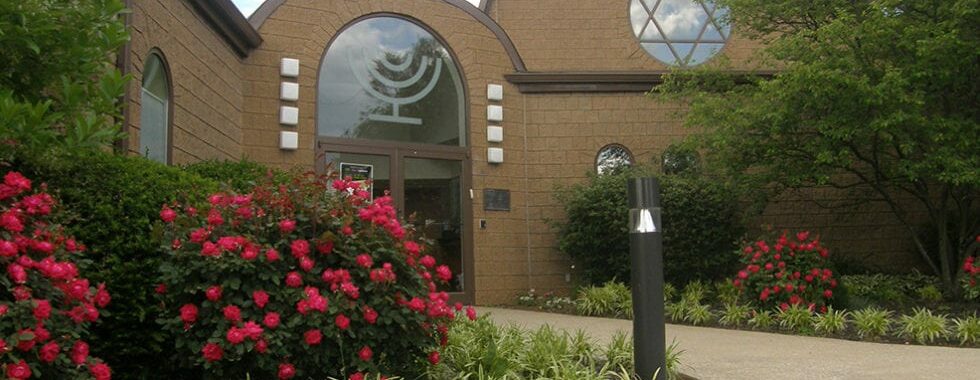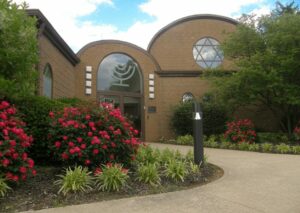By Andrew Adler
Community Editor
Temple Shalom has decided to put its 40-year-old building on the market and move to a space on the campus of the Trager Family JCC.
Congregants voted last month to authorize Temple Shalom’s board to market the existing Lowe Road facility, which synagogue leaders hope will stabilize its finances while providing an opportunity to inject new energy into the Reform congregation. Partnering with the Trager Family JCC will open up the prospect of joint programming initiatives, with an eye toward attracting younger families who might be put off by traditional wor-
ship services.
“We’re welcoming them with open arms,” Sara Klein Wagner, President and CEO of the Jewish Federation of Louis-
ville and the Trager Family JCC, said in a recent interview. “We’re excited about working together.”
“The possibilities are limitless,” says Temple Shalom president Shiela Stein-
man Wallace. “We’re looking to develop a flexible space to accommodate a wide variety of programs – both our own and those in collaboration. We recognize that we need to change and adapt to meet the needs of the next generation. Change is hard, but we understand that we must embrace change.”
Conversations about Temple Shalom possibly moving to a new location began in 2021. It had become clear that the existing building, designed by Gerald Baron to accommodate religious school classes that no longer exist, no longer fit the needs of a congregation faced with mounting bills and – like so many synagogues across the nation – declining
membership. At its peak, Wallace said, Temple Shalom comprised about 250
families. The current membership is less than half that.
The existing facility “has served us well,” Wallace says. “But there’s a recognition that to meet the programming needs of the next generation, significant changes would have to be made.” Multiple pressures are at play. For instance, “the pews are anchored to the floor, which limits what we can do in the sanctuary. The building is in need of significant repairs and maintenance. Currently, we rent out a good portion of our space during the week to Montessori Torah Academy, and it’s gotten to the point where if we need to have meetings during the day, we sometimes have to “ask them” to allow time for us to use our boardroom. On Sunday mornings we have a church that rents from us.”
Wallace – Editor Emeritus of Community – has long observed the aging of Temple Shalom leadership. “I’m 70 years old. When I joined the temple board I was one of the youngest people,” she says. This year, for the first time we have
five board members who are 60 and under – one who’s in their 40s and a couple in their 50s. That’s a big step forward for us. The next generation is starting to come on board.”
Not surprisingly, many congregants have forged strong emotional attachments to the existing synagogue. Indeed, when an initial proposal to move elsewhere was put before the membership
some years ago, the proposal was defeated. “It ended up splitting the congregation instead of bringing us together, Wallace recalls. “But the realities didn’t change. We tried, again, to make it work at our current facility, but it became very obvious that we needed to do something different.”
With that goal in mind, Temple Shalom put together a Bayit Committee to identify and evaluate various options. (“Bayit” is Hebrew for “Home” – an appropriate moniker for a group tasked with figuring out where best to situate
itself). “We have to find creative ways to survive,” says Bayit Committee co-chair Beth Glazier, “to be sustainable, to bring people back in even if you’re not going to get them to be members. So how can you get them involved in other ways? How can you get their kids interested?”
A predecessor visioning Fifth Decade Committee — after deciding against various competing options – began looking at the Trager Family JCC as a viable alternative. Planners were “interested in a colaborative, transformational business,” Glazier said. In 2022, the newly formed Bayit Committee picked up on that proposal. “We talked among ourselves and did the pros and cons; got in touch with Sara and (Federation board chairman) David Kaplan, who is a member of our temple board, and the Trager Family JCC seemed like a marvelous opportunity to put little Temple Shalom – heimish Temple Shalom – at the center of Jewish life in Louisville.”
There’s a lot still to be determined: when the Temple Shalom building will be formally put on the market, an exact timetable for transitioning to the Trager Family JCC, and where in that facility worship services will be held. The Trager Family JCC is developing Phase Two of campus construction, which will include determining what to do with the old Anshei Sfard synagogue. Temple Shalom could end up in or near that synagogue, or in a dedicated space yet to be built.
Initially “we need a third-party appraisal” of the present Temple Shalom building Glazier says, “and then we’ll move forward from there. Our plan – which we’re going to discuss with the Trager Family JCC folks – is to begin a transition so that the members of our congregation get used to having a Shabbat service once a month, and maybe having a program there. “We have a commitment with Montessori Torah Academy though the end of July, although that could be moved a little bit if we ended up selling the building,” Glazier added. “So I assume (the move would occur) sometime over the summer. It would be really helpful for the rabbi (Beth Jacowitz Chottiner, who’s currently on a two-month sabbatical) and everybody if we were where we need to be prior to the High Holidays.”
“We are planning two phases,” Wallace says. “One we’re calling the transition and one we’re calling interim. The transition is where we are now; where we’re completing negotiations and will plan several events at the (Trager Family) JCC or — maybe one or two a month — to get our people used to going, so that they feel comfortable, and they know that they’re welcome there. The interim will be once we decommission our current building and march the Torahs” to
their new home.




